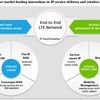The mobile market has come a long way since then, with new devices and services being introduced at an often frantic pace. But, the one thing that remains constant -- and it's what drives subscribers to replace their handsets more frequently than they otherwise might -- personalization.
Personalization at the device level is one factor, and at times, it can prove highly beneficial for mobile operators. One only need look at the adoption rate of the iPhone and then the BlackBerry Storm to understand that subscribers' preferences are being reflected their choice of devices. In fact, Sprint is hoping --perhaps against hope -- that its six-month exclusive with the Pale Pre will help significantly grow its subscriber base.
That, however, isn't an effective way to create a stable subscriber base -- let alone a growing one. Instead, mobile operators must find ways to leverage the affinity for personalization at an even more intimate level -- the application layer.
This requires to, perhaps equally important components. Operators must be able to not only collect as much user data as possible regarding their mobile usage, but they must also understand how to effectively leverage that data. Understanding which new services and applications to introduce is important, but carriers will find much greater return on their new launches by understanding how to roll them out.
It means having the ability to analyze complex sets of subscriber data to identify subscriber groups and, most importantly, the most influential members of those groups. Mobile applications (and devices, for that matter), are highly viral in nature, and knowing which subscribers are most dominant within their communities can pay off in spades.
Of course, being able to glean that level of detail from subscriber data is only part of the challenge. The other requisite component is having the network resources to deliver next generation services and applications reliably and efficiently. While service adoption is extremely viral, subscriber churn is equally susceptible to the influence of friends and family members, and with new devices and enticing offers available from all carriers, an inability to deliver on promises will go a long way towards creating a less than stellar reputation.
Knowing that, it is incumbent upon network operators to not only ensure their networks are capable of delivering their existing offerings, but to also ensure their viability into the foreseeable future. Which is why many, including Verizon Wireless, are already looking at deploying LTE (Long Term Evolution) technologies as a way of mapping out their network growth plans.
An end-to-end LTE solution, such as that developed by Alcatel-Lucent, allows operators to evolve their existing 2G and 3G networks into all-IP infrastructures capable of delivering the latest multimedia applications quickly and reliably.
Alcatel-Lucent CEO Ben Verwaayen noted that the increased bandwidth enabled by LTE, along with its natural ability to co-exist with existing 3G infrastructures, are the foundation for the next generation of communications networks, enabling the economical evolution from 3G to 4G to enable new, innovative, sticky service offerings that operators can leverage to drive subscriber loyalty.
LTE brings to the mobile market data speeds comparable to traditionally faster fixed-line networks, with reduced latency, to ensure an increasingly positive user experience when accessing the real-time multimedia services that are driving the application developer community. Indeed, moving to LTE will enable mobile operators to deliver a competitive user experience through a combination of performance, quality, and coverage.
To find out more about Alcatel-Lucent's LTE solution, along with how operators can leverage it to take advantage of the latest applications trends, including how to capitalize on the desire for personalization, join the company at the Mobile 2012 Virtual Tradeshow, an online experience on June 11, 2009.
Of course, you will have the opportunity to personalize your own experience at the event when you visit Alcatel-Lucent's virtual booth for real-time conversations with Alcatel-Lucent's LTE experts.









